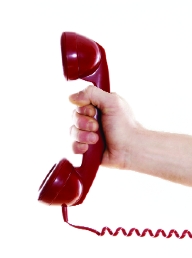Projecting a Professional Phone Manner
Discover strategies for showing yourself to your best advantage on the phone.

It’s time to record a new voice mail greeting (you have, after all, had your current one for 3 years now). You dig out the instruction booklet and figure out which buttons to push on the answering machine. You’ve rehearsed what you’ll say several times. You take a deep breath, push the button, and . . . immediately trip over your tongue. Back to square one.
Does this scenario sound familiar? If so, you’re not alone. With pitfalls ranging from rambling phone messages to unprofessional voice mail greetings, many fitness professionals could use a little help when it comes to communicating via one of the most-used instruments of our time—the telephone.
Some Basic “Rules”
As a fitness pro, you should project a tone of professionalism with each phone call, whether you’re leaving a message, answering an incoming call or engaging in a phone conversation. No matter which phone task you’re performing, consider these basic suggestions:
Project a Warm, Enthusiastic Tone. “This will help your business image and your rapport with the client,” says Pat Rigsby, MS, co-owner of Fitness Consulting Group in Elizabethtown, Kentucky. The client doesn’t want to feel he’s bothering you. Make him feel he is an important part of your day.
Speak Slowly, Clearly and With Conviction. You don’t want clients thinking they’re interrupting or causing you more stress, says Rigsby. “Rushing through a conversation makes the client feel unimportant and portrays that you are disorganized.”
Stay Focused on the Conversation or Message. Being on the phone is not the time to be multitasking. “Don’t allow yourself to be distracted by items on your desk, computer, Blackberry® or phone, or by other people in the room,” says Kate Larsen, PCC, owner of Winning LifeStyles Inc. in Minneapolis. “Be very present, and pay attention to your client and what she’s trying to say.”
Sit Tall or Stand to Project a Strong, Confident Voice. “Don’t sit or hunch down at your desk or over your phone,” adds Larsen. Doing so will make your voice sound weak, tired and unsure.
Be Friendly, but Not Too Familiar. “Being friendly is taking note of happenings in your client’s life,” explains Suzanne Gove, owner of Fitness Leaders Online in Auburn, California. Asking how a child’s birthday party went, for instance, is fine. But, she says, asking for details, such as how much money was spent on the occasion, crosses the line and is overly familiar and unprofessional (not to mention nosy).
Avoid the Use of Slang. “A client is a client no matter how well you know [him], and as such, the tone, while friendly, still needs to be professional,” says Gove. She recommends avoiding expressions such as “Hey,” “Yo,” “Huh” or any other slang or abbreviated terms that express a lack of professionalism.
Recording Your
Voice Mail Greeting
When done right, your voice mail greeting is a great opportunity for you not only to welcome potential and current clients but also to advertise your business. You’ll want to include the following in your greeting:
The Person the Caller Has Reached. Include both your name and your business name.
Your Availability. Phone tag is irritating and a waste of time, says Larsen. Let callers know if you’ll be away and when you’ll be able to get back to them. “Some people put their daily schedule on their greeting,” adds Larsen. “I do it once a week. Do what best serves you and your clients.”
Caller Action/Direction. What do you want callers to do? Leave you a message, contact you via e-mail, call another number? Let them know.
Bonus. Larsen suggests leaving an inspirational message at the end of your greeting or using the moment to advertise a new product or service (see next point). “The majority of my callers comment on the inspirational message I quickly leave at the end of my greeting,” says Larsen. “Some even say they call once a week just to hear it and get a ‘shot in the arm.’” One example of her inspirational messages is “Keep this great quote from Aristotle in mind: ‘We are what we repeatedly do. Excellence, therefore, is not an act but a habit.’ Hope you’re creating smart habits this week.”
Advertising. Got a new product or service that clients would be interested in? Don’t be shy about including information on it in your greeting. Larsen uses the opportunity to tell clients about her new book. She says, “Review my latest book, Progress Not Perfection: Your Journey Matters, online at www.kate
larsen.com.”
Leaving a Message
We’ve all had well-meaning callers leave never-ending messages on our machines—and even then they may not give you all the information you need. Sometimes you may be that type of caller yourself! It’s important to leave concise messages that give the appropriate information without going overboard and without too many “Uhs” and “Ums.” A good professional message should include the following:
Your Name. Include first and last names. Chances are the person being called knows more than one Joe. Be sure to identify yourself properly.
Time of the Call. Many answering machines will tell this info, but it’s always good to make sure it’s included, just in case.
The Purpose of Your Call. Say, in detailed but concise terms, why you’re calling.
Call to Action. Include what follow-up the person can expect. Is there something she needs to do, such as call you back? If so, include your phone number, even if you think she already has it. Will you be calling her back? Let her know when she can expect to hear from you.
If you leave a message on a cell phone or are calling from one and do not get a response within 24 hours, call again, suggests Gove. “I’ve had a few messages left for me that were either dropped partway through the message or the caller’s phone hit a glitch right when they were leaving the final two digits of their phone number,” she says. “This of course makes a return call a bit difficult.”
The Final Word
Our experts suggest writing out what you’re going to say, especially if you tend to get nervous with anything phone-related. At the very least, jotting down important points you want to include in a message or conversation will help you keep on track and avoid rambling.
The phone can be an integral part of your business and, when used optimally, can improve your business image. “Interacting with prospects and clients over the phone is an important part of most fitness professionals’ businesses,” says Rigsby. “By being attentive to this crucial skill, you’ll build credibility and rapport with prospective clients and strengthen your relationships with existing ones.”





